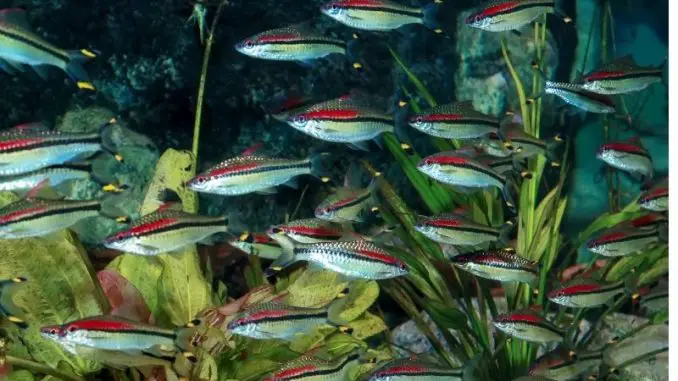
Denison barbs are one of the most attractive barbs that you could get for your aquarium. Their mix of color, size, and interesting behaviors makes them an excellent addition to any peaceful community.
They make excellent beginner fish because they are hardy, and their needs are easy to meet. You just need to maintain a large aquarium for these fish to live out a long and happy life.
This article will cover all the important information when it comes to caring for Denison Barbs. We’ll talk you through their preferred water conditions, perfect tank mates, ideal diet, and much more…
TABLE OF CONTENTS
Denison Barb Facts & Overview

| Category | Rating |
| Care Level: | Easy |
| Temperament: | Peaceful |
| Color: | Silver with patches of red and yellow |
| Lifespan: | Up to 5 years |
| Size: | Up to 6 inches |
| Diet: | Omnivore |
| Family: | Cyprinidae |
| Minimum Tank Size: | 55 gallons |
| Tank Setup: | Freshwater with plants and open swimming space |
| Compatibility: | Peaceful community |
The Denison Barb (Sahyadria denisonii) is a tropical freshwater species in the Cyprinidae family. You might see it under a variety of other names, such as Denison’s Barb, Rosaline Shark, Red-line Torpedo Barb, Bleeding Eye Barb, and Miss Kerala.
The family contains lots of famous fish, including carps, minnows, and other barb species. Perhaps the most popular member is the Goldfish.
Denison Barbs are native to India. They occupy fast-flowing rivers and streams in the Western Ghats.
These fish are very attractive and therefore very popular for keeping at home. They are often removed from their natural habitat for the aquarium trade.
Unfortunately, this exploitation has caused the species to become endangered in the wild, and it may be at risk of going extinct.
The species is commonly sold in pet stores so you should find a stock near to you. They can cost between $10 and $20, depending on their size.
Only buy fish that are visibly healthy. Go to a different pet store if any fish are showing signs of disease on their body or through their behavior.
A healthy fish will live for 5 years or more.
Typical Behavior
If the tank is set up properly with plenty of swimming space, then this species is regarded as peaceful. They get on well with other peaceful fish of a similar size.
They are large and active mid-level swimmers, which can be intimidating and stressful for shy species. Aggressive tendencies may emerge if their tank is a bit cramped.
They dart around in shoals, which helps to show off their bright colors. The movement in unison creates an impressive display.
Appearance
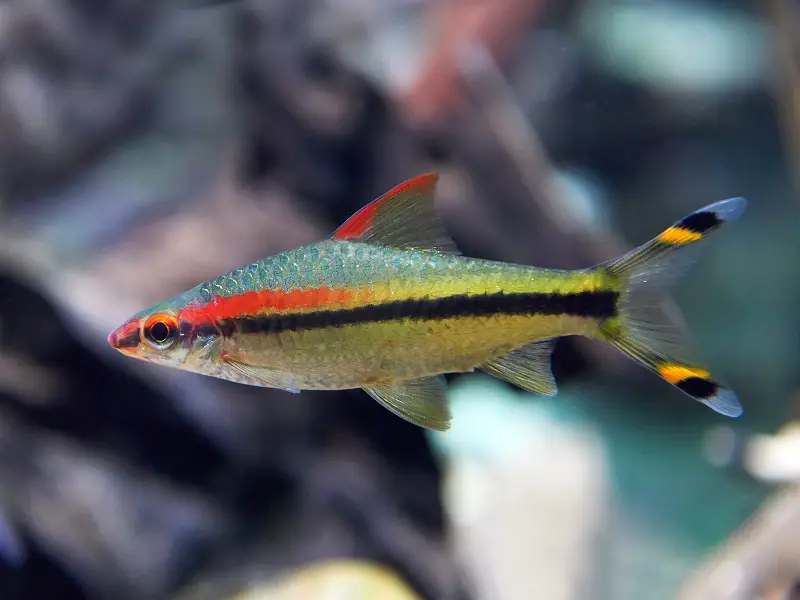
Denison Barbs are a colorful species. Their color is more subtle than most species though, as they have small patches of bright color around their body.
Their base color is silver, which causes light to shimmer when it hits their scales. On the center of their body is a backline, running horizontally along the lateral line from head to tail.
A red stripe sits just above this line, but it only stretches across the front half of the body. The same red can be seen along the top of the dorsal fin.
A bright yellow stripe sits next to a black stripe on each fork of the caudal fin. These are small and only cover the tips.
Where there isn’t red, yellow, or black, the fins are transparent.
A mature individual may have developed an emerald-green color on their head. At this point, they should have reached their average size of about 6 inches.
Sexing Denison Barbs can be difficult. The main indicator is size; Females tend to be slightly larger with duller colorations.
Habitat and Tank Conditions
Denison Barbs are endemic to India, meaning that they are only found there.
They live in the fast-flowing Achankovil, Pamba, and Chaliyar rivers of the Western Ghats (a large mountain range).
Shoals of Denison Barbs group around rocky areas with thick vegetation. The combination of a strong current with vast amounts of vegetation creates a highly oxygenated environment.
The water would be warm with an alkaline pH.
These are the conditions you could be trying to recreate in your aquarium. Fish do best when their home resembles their natural habitat.
Tank Conditions
Layer the bottom of the tank with sand or fine gravel. If other fish in your tank need something a bit different, you can change this since Denison Barbs usually swim higher up in the water column.
You can add decorations on top of the substrate forming some hiding space for when they are stressed.
More importantly, though, add plenty of live plants. Ensure there are some dense patches of vegetation dotted around the aquarium.
Leaving open space is just as valuable as adding things to the tank, if not more so. Denison Barbs need plenty of open swimming spaces for their active and social lifestyle.
The water temperature should be between 60°F and 77°F. The pH should be 6.6-7.8.
A powerful filter outlet should create enough water movement, but you could use a water pump instead.
What Size Tank do they need?
Reaching 6 inches, these fish are quite big. Therefore, they need a large tank to accommodate them. Especially since they need plenty of swimming space.
The minimum tank size is 55 gallons.
How Many Can be kept per gallon?
Denison Barbs are a shoaling species, so they need to be in a group of at least 6. For each additional fish, make sure you have an extra five gallons of water.
Tank Mates

There are lots of possible tank mates for Denison Barbs. They are peaceful and social if they have enough space.
Any fish you add should be a similar size and be peaceful themselves. Avoid shy/delicate fish too, as they may struggle around your busy Denison Barbs.
Some popular options include rainbowfish, kribensis cichlids, danios, large tetras, or other barbs (cherry, rosy, tiger, etc.).
Small shrimps and snails will be fine in the same tank as your Denison Barbs as well.
Can You Keep Denison Barbs Together?
These fish should always be kept in a group. If a fish is kept singly, it will become lonely and stressed, choosing to hide away.
Make sure you have at least 6, but the larger the group, the happier they will be. They feel safe when grouped up in large numbers.
Diet
These omnivores will eat the most common aquarium food that you might want to give them.
The best options are live/frozen foods that are full of nutrients. You could try Daphnia, bloodworms, and brine shrimp.
You can use dried foods (flake and pellets etc.) but they are less nutritional, so supplement them with something else.
Provide a varied diet to keep your fish as strong and healthy as possible. It will also help to maintain their bright colors.
Give them an amount of food that they can easily finish within 2 minutes. Do this 2-3 times a day.
Care
Denison Barbs are easy to care for. They are hardy and can tolerate a range of conditions.
If you want them to live out their lifespan though, you will need to feed them a healthy diet and keep their environment clean – perform regular water changes and wipe away excess algae.
Use a water testing kit each week so you can spot changes in the water conditions quickly. You can then respond before your fish are affected.
Poor water conditions can lead to disease. There aren’t any species-specific diseases, but there are some common pathogens that affect most species.
Ich is one famous example. It is an ectoparasite that presents as white spots on a fish’s body, which makes it very noticeable.
Separate a diseased fish into a quarantine tank to protect the rest of your fish. You can return it once the treatment is complete.
Breeding
Breeding Denison Barbs at home are very tricky. Sometimes it will happen on its own, but there is not much that you can do to influence the process.
Luckily, commercial breeders do not have the same problem. They can create vast setups and use hormones to trigger spawning.
All we know is that Denison Barbs seem to prefer breeding in soft water towards the acidic side of their ideal pH range. Live plants are also essential for egg scattering.
Are Denison Barbs Suitable for Your Aquarium?
Denison Barbs are suitable for anyone with a large enough aquarium. They are easy to care for, but they grow quite large and need plenty of open swimming space.
You may struggle to get them to breed, but otherwise looking after them is a breeze.
Plan a healthy and varied diet, and make sure that all tank mates will be able to cope with the busy lifestyle of a shoal of Denison Barbs.
Their colors make them an attractive option that even beginners can enjoy. You will always have something to look at as their reds and yellows dart around the tank.
Do you keep Denison Barbs at home? Let us know about your setup in the comments below…


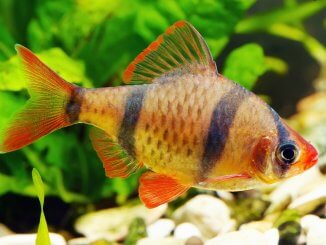
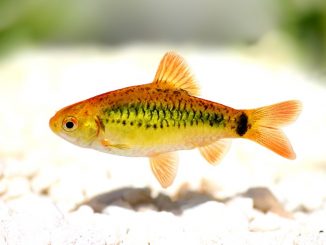

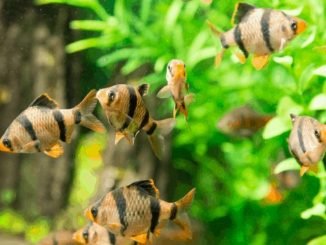
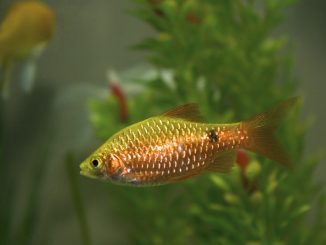
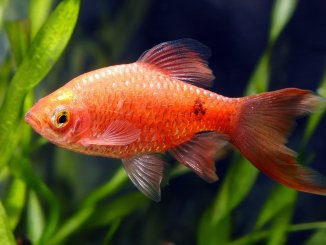
Be the first to comment